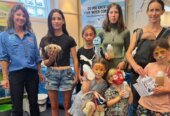
A kokako chick
The Pirongia Te Aroaro o Kahu Restoration Society has recorded one of the busiest 12 months in its 15-year history despite having to “adapt quickly” to the unprecedented challenges of Covid-19.
A total of 110 of the roughly 350 volunteers on the society’s books logged about 9300 volunteer hours – more than 10 percent up on the previous 12 months.
The group carries out a wide range of environmental tasks – including using bait stations to target a range of pests including rats and possums and stoats – on both Mt Pirongia and at Okahukura in the Pureora Forest area.
Its work on Mt Pirongia and at Okahukura spans 14 and five years respectively.
With more than 2200 bait stations now covering 2000 hectares of bait control – and spanning 195km of bait lines – across the two sites, society chair Clare St Pierre said the group would look to expand that by up to 250 hectares in the near future.
In addition, 2020 also saw the society record its largest volunteer numbers on a single day of bait station filling at Okahukura – when nearly 70 people were present.
Ms St Pierre said that level of attendance saw the entire 1000ha bait station grid it has established there serviced in a day – reducing rats in the area by nearly 30 percent this season.
“We were also delighted by how fast we were able to get back to work when the country shifted to Alert Level 2.”
Aside from one part time staff member – hired in the last 12 months – the society is run entirely on a voluntary basis and she lauded the long-term commitment those volunteers have shown.
A highlight in the society’s tenure, she said, had been the re-introduction of kōkako to Mt Pirongia after an absence of several decades.

Group members on Mt Pirongia
Volunteers now monitor the progress kōkako are making on the mountain at nesting sites, as well as maintaining areas of the native plant dactylanthus tayloriis.
“I think the presence of kōkako again has filled people with so much joy – we’ve definitely seen a surge in our volunteer numbers, likely in part because people just love the monitoring work we do on that front.”
Society volunteers’ busiest time of year gets underway from next month, during which they re-fill the group’s bait station network twice a year and then monitor kōkako nests each week through until March.
This season saw nesting attempts by only four breeding kōkako pairs – a number which may have been higher had there not been summer and autumn drought conditions.
Seven chicks were added to the population.
Other milestones of note from the past 12 months highlighted aththe society’s annual meeting this month included the presentation of a life membership to Selwyn June and the upgrading of the society’s Envirocentre building in Pirongia Village.
Last year’s committee was re-elected and new committee members Andy Bryant and Brian Bowell added.








